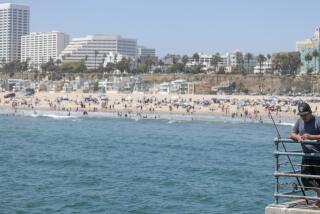‘Remarkable’ warming reported in Central California coastal waters
- Share via
Ocean temperatures along the Central California coast experienced a “remarkable” warming period during the first three weeks of July, leading to unusual encounters with some fish species, scientists reported.
The warmer ocean correlated with weaker winds, which reduced coastal upwelling, allowing warmer water to move inshore, according to the National Oceanic and Atmospheric Administration.
The warming is related to unusual weather pattern seen in the Sierra Nevada, where recent thunderstorms have pummeled dry forest lands with bursts of rain and lightning, Nate Mantua, Team Leader of Landscape Ecology for Southwest Fisheries Science Center, said in an email.
The upper ocean within 50 to 100 miles of the coast has been 3.6 to about 7 degrees Fahrenheit warmer than what’s typical for this time of year, mostly south of the Golden Gate, he said.
“Scientists and many others that are interested in our ocean are paying close attention to this warming because it will likely impact marine life, and it could impact marine life beyond this summer,” he said.
For instance, warming of the upper ocean usually comes with changes in the plankton and fish communities found along the California coast, he added.
The warm water reached depths of 20 to 40 meters, allowing “unusual encounters” with ocean sunfish and jellyfish called “sea nettles,” scientists with NOAA’s Southwest Fisheries Science Center reported during a survey on the Tomales Bay and Pigeon Point.
The jellyfish were also spotted farther north than they are typically seen.
If the warming continues this summer, he said more subtropical species like ocean sunfish, albacore, dorado, yellowtail, yellowfin or bluefin tuna, or humboldt squid could move into water near the shore. The species typically avoid those waters when it is colder.
But if the warming persists into fall, Mantua warned some cold-environment species could suffer reduced growth, poor reproductive success and population declines. Warm-water species, however, may experience a reproductive boom.
Rick Powers, owner of Bodega Bay Sport Fishing Center, said he has seen plenty of ocean fish recently, but more so since the water has become noticeably warmer.
“As far as productivity, our trips have been successful all summer,” he said.
Rockfish has been particularly active and salmon fishing was “good,” but they appeared to be closer to the sea floor, Powers said.
Still, he said the warmer ocean temperature could indicate something else.
“I really believe we have some type of El Niño in progress,” Powers said.
An El Niño weather pattern would bring more exotic fish, including Marlin, Dorado and white seabass, offshore during September, October and November.
But Mantua said, the patches of warm water in the North Pacific don’t appear to related to a tropical El Niño so far.
If an El Niño forms and spreads the warming along the Pacific coast into next winter and spring, he said “impacts on marine life would definitely carry over into next spring and early summer.”
“It would be a double-whammy of bad news for California’s Pacific salmon that are currently under stress in their freshwater habitats from the ongoing drought,” Mantua said.
In June, the National Oceanic and Atmospheric Administration reported that the first six months of this year were the hottest ever in California. And it was the second warmest year, on average, in Los Angeles in the last 70 years.
Just last week, forecasters said the chances of a wet El Niño weather pattern decreased to about 65%, and if it does arrive, it will probably be weaker than originally expected.
For breaking news in Los Angeles and throughout California, follow @VeronicaRochaLA on Twitter. She can be reached at [email protected].
More to Read
Sign up for Essential California
The most important California stories and recommendations in your inbox every morning.
You may occasionally receive promotional content from the Los Angeles Times.









